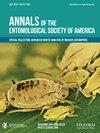雌性破坏瓦螨(中污目:瓦螨科)取食和繁殖的内部解剖组织学图谱
IF 1.8
3区 农林科学
Q1 ENTOMOLOGY
引用次数: 5
摘要
对瓦氏破坏螨(Anderson and trueman, 2000)的组织切片进行组织化学染色,揭示了其体内结构,并用于对比饥饿和新近进食的雌性螨与进食和繁殖相关的内部器官。颌体由一个强大的吸吮咽组成,它使用11块交替的扩张肌和收缩肌、chelicerae、唾液管和唾腺。冠状面,通过食道上区和食道下区之间的联神经节可见食道,并在后方与中肠相连。在饥饿的螨虫中,中肠缺乏食物颗粒,但在喂食的螨虫中,中肠上皮细胞充满了无数充满脂蛋白的球状球体,包括多不饱和脂质,而管腔则充满了饱和脂质或其他未知的营养物质。在被喂食的雌鼠的胆小体区域,双叶lyrate器官一侧与中肠相邻,另一侧与卵巢相邻,细胞间的联系非常紧密,似乎形成合胞体。被喂食的雌性卵巢包含一个巨大的增大的卵子,以及许多从lyate器官延伸出来的细长的哺乳细胞。染料对脂蛋白的选择性染色表明中性和多不饱和脂质和脂蛋白的快速掺入。在雌性受精卵中,靠近卵巢的精子囊也很明显,充满了细长的、完全有能力的精子。本研究报告的组织学和组织化学发现为这种有害的蜜蜂寄生虫和病媒的雌性身体结构,营养和生殖活动提供了新的见解。图片摘要:典型组织学图像(中估计:Varroidae): A.前体区显示咽部、食道、太阳神经节和唾液腺(矢状面);B.身体中段显示中肠上皮细胞内的细胞内囊泡(脂蛋白)(矢状面)。C.身体后部显示卵巢,发育中的卵母细胞通过细长的哺乳细胞连接到lyrate器官;D.身体后部显示卵巢,发育中的卵母细胞非常大,邻近的精囊和lyrate器官。所有的图像都是雌性的。本文章由计算机程序翻译,如有差异,请以英文原文为准。
Histological Atlas of the Internal Anatomy of Female Varroa destructor (Mesostigmata: Varroidae) Mites in Relation to Feeding and Reproduction
Abstract Histochemical staining of histological sections of Varroa destructor (Anderson andTrueman, 2000) mites reveal the internal body plan and are used to contrast the internal organs associated with feeding and reproduction of starved versus recently fed female mites.The gnathosoma is comprised of a powerful sucking pharynx, which employs 11 alternating dilator and constrictor muscles, the chelicerae, the salivary ducts, and the salivarium. Coronally, the esophagus is visible through the synganglion between its supraesophageal and subesophageal regions and connects posteriorly to the midgut.The midgut is devoid of food particles in starved mites, but in fed mites, the midgut epithelial cells are filled with innumerable globular spheroids replete with lipoproteins, including polyunsaturated lipids, whereas the lumen is filled with saturated lipids or other unidentified nutrients. In the opisthosomal body region of the fed female, the bilobed lyrate organ lies adjacent to the midgut on one side and the ovary on the opposite side, with very close cell to cell linkages that appear to form a syncytium. The fed female ovary contains an enormously enlarged ovum, and numerous elongated nurse cells extending from the lyrate organ. Dyes staining selectively for lipoproteins suggests rapid incorporation of neutral and polyunsaturated lipids and lipoproteins. Also evident near the ovary in fed females is the spermatheca filled with elongated, fully capacitated spermatozoa. The histological and histochemical findings reported in this study provide a fresh insight into the body structure, nutrition, and reproductive activity of the female of this harmful honey bee parasite and disease vector. Graphical Abstract Representative images histological atlas varroa destructor (Mesostimate:Varroidae): A. Anterior body region showing the pharynx, esophagus, sunganglion and salivary gland (sagittal view); B. Mid-section of body showing intracellularvesicles (lipoproteins) in epithelial cells of the midgut (sagittal view). C. Posterior region of body showing of the ovary with developing oocytes connected by elongated nurse cells to the lyrate organ: D. Posterior region of body showing the ovary with a very large developing oocyte, adjacent spermatheca and lyrate organ. All images are fed females.
求助全文
通过发布文献求助,成功后即可免费获取论文全文。
去求助
来源期刊
CiteScore
4.90
自引率
0.00%
发文量
25
审稿时长
6-12 weeks
期刊介绍:
The Annals of the Entomological Society of America exists to stimulate interdisciplinary dialogue across the entomological disciplines and to advance cooperative interaction among diverse groups of entomologists. It seeks to attract and publish cutting-edge research, reviews, collections of articles on a common topic of broad interest, and discussion of topics with national or international importance. We especially welcome articles covering developing areas of research, controversial issues or debate, and topics of importance to society. Manuscripts that are primarily reports of new species, methodology, pest management, or the biology of single species generally will be referred to other journals of the ESA. The most important criteria for acceptance are quality of work and breadth of interest to the readership.

 求助内容:
求助内容: 应助结果提醒方式:
应助结果提醒方式:


